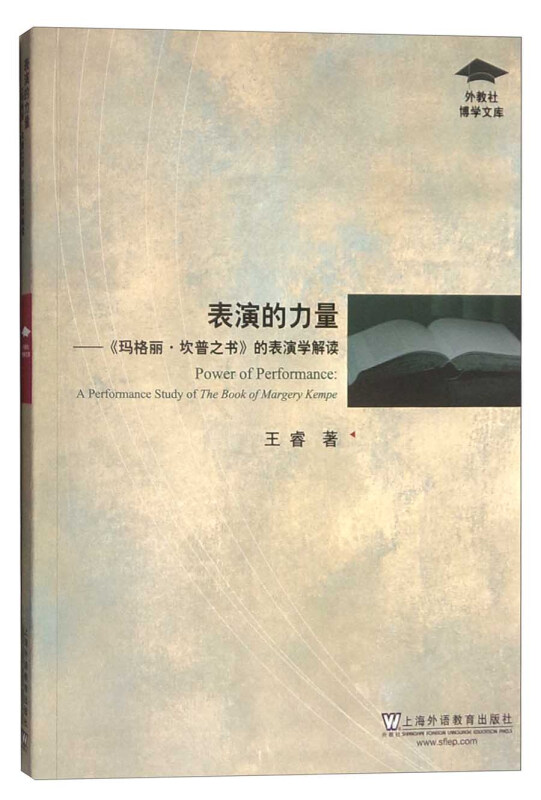- ISBN:9787544641715
- 装帧:暂无
- 册数:暂无
- 重量:暂无
- 开本:32开
- 页数:188
- 出版时间:2015-12-20
- 条形码:9787544641715 ; 978-7-5446-4171-5
内容简介
个体在社会剧场中如何言说、表演,是一个跨越时空和文化的议题。《玛格丽·坎普之书》作为现存的**部英文自传和为数寥寥的中世纪女性写作成果,堪称个性化言说的典范。《表演的力量:的表演学解读(英文版)》细致解读文本和相关文献,批判性地借鉴性别表演理论并融合其他表演学派思想,分析了坎普对语言、身体、空间、服装和沉默等表演要素的管理,意在发掘个体表演与社会剧本不断协商中展现的意蕴和策略,同时彰显中世纪文本与当代社会的恒久关联。
目录
Kempe Studies
The Performative Turn
The Dissertation
Chapter One Butler and Medieval Performativity
From Shakespeare to Butler:The World as Stage
The Theatre of Faith:Margery's Christian-ness as Performance
Chapter Two Late Medieval Cacophony and the Birth of “This Creature”
Butler Trouble
The Never-Solo Land of Margery Kempe
The Birth of a Free-Lance Mystic
Chapter Three The Politics of Speech
Mystical Speech and Austinian Performativity
Speech Felicitous and the Management of Performatives
Speech Infelicitous:Erasure and Penalties
Chapter Four The Poetics of Dissent
New Perforrnatives and the New Theatre
Secular Places,Sacred Space
Dressing Up,Dressing Down
Bodies That Litter
Chapter Five The Poetry of Silence
Silence vs.Silences
The Right of Silence
The Rhythm of Noise
Conclusion
Appendix
Bibliography
节选
The Theatre of Faith: Margery'sChristian-ness as Performance Butler's interrogation of gender formation may thus serve as an analyticalmodel for a performance study of the Book: Could the way gender identitiesare performed into being also apply to religious identities, e.g., the Christian-ness and mystic-ness of Margery? Was late medieval life a mimetic theatre inwhich identities were but subjectivity-nullifying performances, too?9 If ourastonishing Margery was performing as well, how precise was her mimesis orreiteration, how efficacious were her performances, and how was she able to,as it seemed, "escape" performativity and perform at variance? To answer these, the first stop is to revisit the late medieval social theatreand locate the social scripts and directing authorities, so that we can examineher performance in its historicity. Given the breadth of the medieval socialcanvas, the analysis below will focus on the most basic identity of a latemedieval man or woman, that of being a Christian. In theory, a Christian is adescriptive term referring simply to anyone who accepts and believes in theBible's contents and ideas. In execution, however, one is never a Christiantill recognized so by the Church. Just like the Butler baby who is girl-ed intogirlhood by a doctor, a medieval English baby is appellated into its Christianidentity when the priest dabs water on its forehead, saying performatively, "Ibaptize thee in the name of the Father, and of the Son, and the Holy Ghost.Amen."This done, the baby's future-to-be becomes clearly foreseeable. He/She will attend the Mass, since very young and on a weekly basis, and say themorning, noon, evening prayers, or pray over dinners, on a daily basis. He/Shewill also in due turn takes five of the six other sacraments that punctuate anaverage Christian's life journey —— Confirmation, Matrimony or Holy Orders,Extreme Unction. and at ereater freauencies the sacraments of Eucharist and Penance —— each of them marking his/her accession to a new stage of life,wearing a new social identity yet remaining shaded by the umbrella identity ofa Christian. Presumably, one does all this because he is (already) a Christian, yet aButlerian analysis suggests that one is a Christian exactly because he has doneit all in the Christian way. In Butlerian terms, being Christian is a performance,the effect of stylized repetition both in terms of its formation and of itsmaintenance. ……
-

解剖绘画学校:人体
¥16.8¥56.0 -

沈尹默卷-中国最具代表性碑帖临摹范本丛书
¥21.8¥68.0 -

篆书实用字典(文通版)
¥11.2¥35.0 -

观众心理美学
¥8.9¥29.8 -

赵孟頫与吴兴画派(八品)
¥28.6¥85.0 -

面具-中国国粹艺术读本
¥11.2¥35.0 -

音乐的伤痛
¥14.4¥38.0 -

老歌的发现
¥15.4¥48.0 -

百里溪札丛
¥14.4¥45.0 -

与当代艺术家的对话:中国画的生成
¥18.7¥48.0 -

艺术速成读本:文艺复兴艺术(精装版)
¥13.8¥43.0 -

艺术速成读本:建筑(精装版)
¥13.8¥43.0 -

玺印篆刻收藏入门图鉴
¥14.9¥49.8 -

小历史系列失落的墨水:被遗忘但却依然重要的书写艺术/小历史系列
¥16.0¥42.0 -

无名的道路
¥25.4¥59.0 -

摄影术的诞生
¥22.1¥69.0 -

一幅画开启的世界(八品)
¥22.1¥69.0 -

荷花(笔记本)
¥25.4¥59.0 -

黄能馥文集(九品)
¥23.7¥79.0 -

中国风景
¥22.4¥68.0










